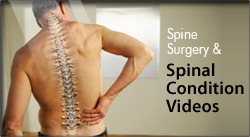Spinal Cord Stimulator
Spinal cord stimulator is a device used for the management of chronic pain in the arm, leg or back caused by reflex sympathetic dystrophy, failed back syndrome, arachnoiditis and other conditions. Spinal cord stimulators are recommended only when conservative treatments or any surgical procedure is not capable of relieving the pain. The device delivers electrical pulses to the nerves in the spinal cord that are causing pain. These impulses interfere with the transmission of pain signals, from these nerves to the brain, resulting in a tingling sensation rather than pain.
The spinal cord stimulation system consists of a pulse generator with an built-in battery, a lead with a number of electrodes to deliver the pulses to the spinal cord and an extension wire to connect the pulse generator to the lead. A hand held remote control is also provided to adjust the strength and frequency of the pulses or to turn off the pulse generator, if required. The implant is considered only in a few selected patients who experience a significant pain relief after a trial stimulation test and offers several benefits for them, some of which are listed below;
- It is safe and effective
- It reduces the dose of the pain medications as well as their associated side effects
- It can be targeted to specific locations and programmed according to the specific needs of each patient. If required, it can also be adjusted to match the change in pain patterns in a patient
- If not beneficial, the system can be surgically removed or turned off
Procedure
Before the final implantation, trial stimulation is carried out to select the ideal candidate (demonstrates more than 50% reduction in pain) and to determine the position and the number of leads required for an optimal outcome.
Permanent implantation of the spinal cord stimulator is done under the guidance of intra-operative fluoroscopy. The patient lies face down on the operating table. A mild sedative is given to relax the patient. A local anesthetic is administered to numb the area of incision. A midline incision is made over the anesthetized region and the lamina is exposed. A small portion of the lamina is removed to make a place for the leads, which are then placed in the epidural space and fixed with sutures. The number of the leads required and their positions vary among different patients.
The implanted leads are connected to an external pulse generator and the patient’s response to the impulses and its effect on intensity of pain are evaluated. The patient does not experience any pain or discomfort during the test stimulation. The response of the patient during the test stimulation helps the surgeon to determine the best setting of the stimulator to maximize the pain relief for the patient. The patient is again sedated and an extension wire is passed under the skin, to the abdomen or the buttock, where the pulse generator is to be implanted. A separate incision is made below the waistline to implant the pulse generator. The pulse generator is then placed between the skin and the muscle layer in a space made in the abdomen or buttock, and is sutured to the fascia. It is connected to the extension wire coming from the implanted leads and then both incisions are sutured closed. Patients are usually discharged the same day or the following day of the implantation. It is crucial to keep the incision site clean and dry till complete healing occurs.
Risk
All surgeries are associated with some risk. The risk associated with spinal cord stimulator implantation is relatively low but may include bleeding, infection, nerve injury and damage to spinal cord. In rare cases it may also lead to paralysis and death.
|








